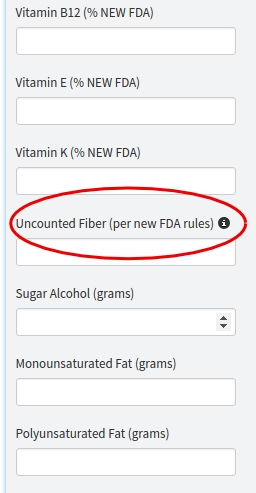New FDA Fiber Definition
Fiber has always been one of the required elements for the nutrition label, but the FDA never specifically defined what they meant by it. Total fiber was just that—the sum of all the fiber, soluble and insoluble, in a product. That's changed with the new labeling guidelines, and they've issued a definition, or at least they've started to. Here's where things stand now.
Not All Fiber Is Equal
Under the new rules, fiber's being categorized as either "beneficial" or not. The "non beneficial" category includes: inulin, bamboo fiber, soy fiber, pea fiber, wheat fiber, cotton seed fiber, sugar cane fiber, sugar beet fiber and oat fiber. The practical effect is that all of those are no longer counted in the total fiber amount. They are still part of total carbohydrates, though.
What It Actually Means
Let's say you make a cookie that you've created to be high in fiber. You've got whole wheat and whole oats in it, and you add some extra oat fiber to the recipe. Each serving gets 4 grams of fiber from the whole wheat, 6 grams from the whole oats, and another 10 grams from the oat fiber.
On the old label, the total fiber per serving would be 20 grams (4+6+10). On the new label, each serving will have only 10 grams of total fiber (4+6) because only "beneficial" fiber gets counted, and the 10 grams from the oat fiber aren't considered beneficial. But on both labels the full 20 grams will be part of the total carbohydrates.
Changes In ReciPal
We've added a new field in the ingredient form under "optional nutrients and details" called "Uncounted Fiber (per new FDA rules)." Whatever is added to this field will be subtracted from the total fiber in the new FDA label formats in our nutrition label maker. This is where you should include the amount of fiber from the sources listed above (inulin, oat fiber, etc.)

Here's where you enter those non-beneficial fibers!
We've gone through the public database and updated the "non-beneficial" fiber ingredients, but you should go through your own ingredients and check them, as well as keep it in mind for creating new ingredients. You want to look for and update the information for any of these fibers that might be listed by a different name, created as a private ingredient, or present in a processed ingredient you use.
Don't Forget The Records!
With this new rule come new requirements for keeping records. We've already written about those requirements (and the ones for added sugar) in a blog post on the new FDA record keeping rules.
The Take Away
Basically, if you're adding fiber to your product, or if one of the ingredients you're using has one of the "non-beneficial" fibers added to it, be aware that it won't contribute to the total fiber in the new FDA label and that you have to track what's been added.
The FDA isn't making this current classification their final word: they'll be evaluating the "non-beneficial" fibers to see if maybe they are beneficial after all and the FDA will update the rule accordingly. So stay tuned.






